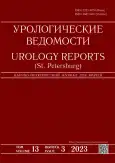Experience of the 193 small intestine reconstructions of ureters
- Authors: Komyakov B.K.1,2, Al-Attar T.K.1,2, Kirichenko O.A.2, Mkhana K.M.1, Pirozhok J.S.2
-
Affiliations:
- North-Western State Medical University named after I.I. Mechnikov
- City Multidisciplinary Hospital No. 2
- Issue: Vol 13, No 3 (2023)
- Pages: 229-237
- Section: Original articles
- URL: https://bakhtiniada.ru/uroved/article/view/148345
- DOI: https://doi.org/10.17816/uroved601823
- ID: 148345
Cite item
Abstract
BACKGROUND: The ureteral plastic surgery with their extended constrictions and obliterations remains one of the most difficult problems of reconstructive urology. This is especially true in cases where it is impossible to repair the patency of the ureter due to unchanged urinary tract sections. In such cases, various segments of the gastrointestinal tract and, above all, the ileum proved to be the best plastic material. However, the number of such operations in the world is not enough, which requires further accumulation of experience and study of long-term results of ileoureteroplasty.
AIM: The aim of the research is to present the technical features and results of intestinal plastic surgery of ureters.
MATERIALS AND METHODS: From 2001 to 2023 ileoureteroplasty was performed in 193 patients of the Clinic of the North-Western State Medical University named after I.I. Mechnikov on the basis of the urological department of City Multidisciplinary Hospital No. 2. The panel consisted of 71 men (36.8%), 122 women (63.2%). The average age was 51 ± 3.2 years. Indications for these operations were extensive defects of the ureters as a result of complications of surgical intervention on the upper urinary tract in 69 (35.8%) of patients, radiation therapy — in 54 (28.0%) and the consequences of iatrogenic damage to the ureters — in 40 (20.7%). Megaureter (6.2%), Ormond’s disease (7.3%) and neoplasms of the ureters (2.0%) were observed less frequently.
RESULTS: Unilateral ileoureteroplasty was performed 153 (79.3%), bilateral — 40 (20.7%). The total number of ureteralsurgeries is 235. Since 2013 ileureteroplasty has also been performed with laparoscopic method, and the share of such operations for this period was 35.9%. The early postoperative complications occurred in 18 (9.3%) patients. There were no fatal outcomes. Late complications developed in 16 (11.2%) of 143 examined patients.
CONCLUSIONS: This surgical tactics may be recommended in the clinical practice of large urological hospital due to our 22-year experience in using small intestine segments to replace extended ureteral constrictions with a minimum number of postoperative complications, no deaths and good long-term results allows us to recommend.
Full Text
##article.viewOnOriginalSite##About the authors
Boris K. Komyakov
North-Western State Medical University named after I.I. Mechnikov; City Multidisciplinary Hospital No. 2
Email: komyakovbk@mail.ru
ORCID iD: 0000-0002-8606-9791
SPIN-code: 7864-9123
MD, Dr. Sci. (Med.), professor, head of the Department of urology, head of the Urological Unit
Russian Federation, Saint Petersburg; Saint PetersburgTalat Kh. Al-Attar
North-Western State Medical University named after I.I. Mechnikov; City Multidisciplinary Hospital No. 2
Author for correspondence.
Email: dr-talat@mail.ru
ORCID iD: 0000-0002-2080-5637
SPIN-code: 9550-7507
MD, Dr. Sci. (Med.), professor of the Department of urology, urologist
Russian Federation, Saint Petersburg; Saint PetersburgOleg A. Kirichenko
City Multidisciplinary Hospital No. 2
Email: oa.kir@mail.ru
MD, Cand. Sci. (Med.), urologist
Russian Federation, Saint PetersburgKhusam M. Mkhana
North-Western State Medical University named after I.I. Mechnikov
Email: viphussam@mail.ru
postgraduate student, Department of urology
Russian Federation, Saint PetersburgJulia S. Pirozhok
City Multidisciplinary Hospital No. 2
Email: ulia_pirozhok@mail.ru
urologist
Russian Federation, Saint PetersburgReferences
- Komyakov BK. Kishechnaya i appendikulyarnaya plastika mochetochnikov. Moscow: GEOTAR-Media, 2015. 416 p. (In Russ.)
- Loran OB, Sinyakova LA, Seregin AV, et al. Ispol’zovanie izolirovannykh segmentov kishechnika v operativnom lechenii luchevykh povrezhdenii mochevyvodyashchikh putei. Urologiia. 2012;(2):20–24. (In Russ.)
- Kotov SV, Guspanov RI, Yusufov AG, et al. Long-term results of ureteral replacement using small bowel in patients with long strictures: 9-years single-center experience. Urologiia. 2023;(4):5–11. (In Russ.) doi: 10.18565/urology.2023.4.5-11
- Armatys SA, Mellon MJ, Beck SDW, et al. Use of Ileum as ureter replacement in urological reconstruction. J Urol. 2009;181(1): 177–181. doi: 10.1016/j.juro.2008.09.019
- Komyakov B, Ochelenko V, Mhanna H. Ureteral substitution with intestinal segments. J Urol. 2020;203(4S):e597–598. doi: 10.1097/JU.0000000000000890.08
- Okumura Y, Akamatsu S, Okada Y, et al. Clinical utility of upper urinary tract reconstruction by Ileal-ureter substitution. Hinyokika Kiyo. 2018;64(3):87–94.
- Zhong W, Hong P, Ding G, et al. Technical considerations and outcomes for ileal ureter replacement: a retrospective study in China. BMC Surg. 2019;19(1):9. doi: 10.1186/s12893-019-0472-1
- Komyakov BK, Al-Attar TKh, Guliev BG. Intestinal and appendicular ureteral substitution. Urologiia. 2021;(2):14–20. (In Russ.) doi: 10.18565/urology.2021.2.14-20
- Kochkin AD, Gallyamov EA, Popov SV, et al. Laparoscopic ileal ureteral substitution. Results of the first 40 operations. Urologiia. 2018;(5):5–12. (In Russ.) doi: 10.18565/urology.2018.4.5-12
- Komyakov BK, Guliev BG, Ochelenko VA. Technical features of uretral intestinoplasty. Part 3. Laparoscopic ileo- and appendiceal ureteroplasty. Urologiia. 2016;(4):4–9. (In Russ.)
- Monn MF, Roth JD, Bihrle R, Mellon JM. Long term outcomes in the use of ileal ureter for radiation-induced ureteral strictures. Int Urol Nephrol. 2018;50(8):1375–1380. doi: 10.1007/s11255-018-1904-z
- Kocot A, Kalogirou C, Vergho D, Riedmiller H. Long-term results of ileal ureteric replacement: a 25-year single-centre experience. BJU Int. 2017;120(2):273–279. doi: 10.1111/bju.13825
- Esmat M, Abdelaal A, Mostafa D. Application of Yang–Monti principle in ileal ureter substitution: is it a beneficial modification? Int Braz J Urol. 2012;38(6):779–785. doi: 10.1590/1677-553820133806779
- Ordorica R, Wiegand L, Webster J. Ureteral replacement and only repair with reconfigured intestinal segments. J Urol. 2014;191(5):1301–1306. doi: 10.1016/j.juro.2013.11.027
- Komyakov BK, Guliev BG, Ochelenko VA, et al. Technical features of intestinal ureteroplasty. Part 4. Yang–Monti ureteric reconstruction with reconfigured ileal segment. Urologiia. 2016;(5):21–26. (In Russ.)
Supplementary files

















